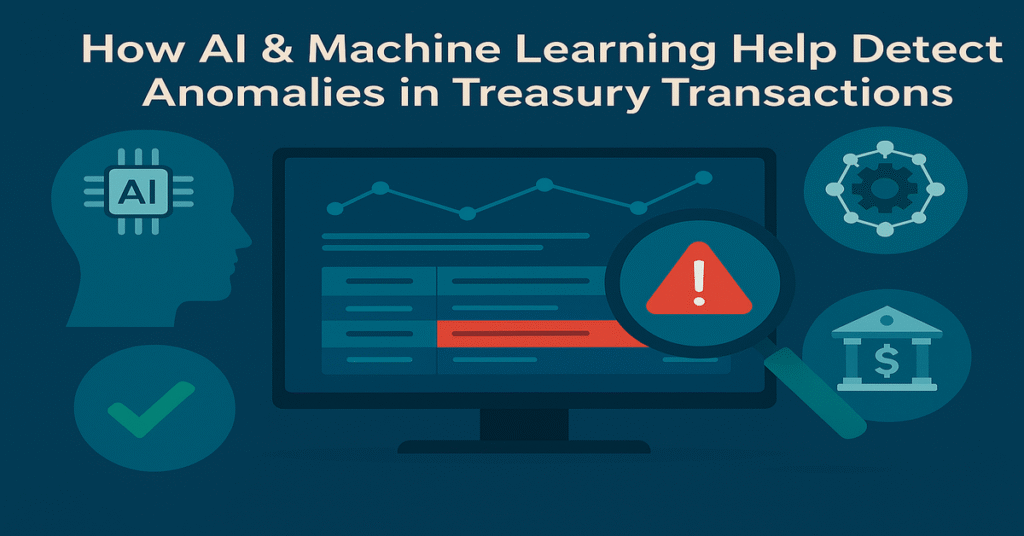Treasury transactions are the backbone of corporate finance, handling massive cash flows, investments, and risk management activities daily. But with great financial power comes great risk—fraud, operational errors, and system glitches can lead to significant losses if not caught in time.
Traditionally, anomaly detection in treasury operations relied on manual reviews and rule-based systems, which often failedfail to catch evolving threats. That’s where AI and machine learning step in. By analyzing vast amounts of data in real-time, these technologies can spot suspicious patterns, flag irregular transactions, and even predict potential fraud before it happens.
In this blog, we’ll explore how AI-driven anomaly detection works, why it’s more effective than traditional methods, and what the future holds for treasury security.
What Are Anomalies in Treasury Transactions?
Treasury transactions involve high-value fund transfers, foreign exchange deals, and liquidity management. While these transactions follow structured workflows, anomalies—unusual or unexpected activities—can disrupt operations and pose financial risks.
Common types of anomalies include:
- Fraudulent Transactions – Unauthorized fund transfers, insider fraud, or cyberattacks.
- Operational Errors – Incorrect entries, duplicate transactions, or human oversight.
- Market Abuse & Insider Trading – Unusual trading patterns that indicate regulatory violations.
- System Glitches & Data Discrepancies – Technical failures that create inaccurate records.
Traditional rule-based systems struggle to keep up with sophisticated fraud techniques and ever-evolving transaction patterns. A treasury management system can dynamically identify outliers, adapt to new risks, and enhance security without constant human intervention.
How AI & Machine Learning Detect Anomalies
Detecting anomalies in treasury transactions isn’t just about spotting what looks “off.” It’s about recognizing subtle patterns that deviate from the norm—something treasury management systems do exceptionally well.
Unlike traditional systems that rely on predefined rules (like transaction limits or fixed thresholds), AI models learn from data. They analyze historical transactions, understand what typical behavior looks like, and then flag deviations that might indicate fraud, error, or risk.
- Supervised Learning: These models are trained on labeled data—examples of both normal and fraudulent transactions. Over time, they learn to classify new transactions accurately, even as tactics evolve.
- Unsupervised Learning: In many cases, you don’t have labeled fraud data. Unsupervised models identify patterns and cluster behaviors. If a transaction suddenly doesn’t fit the usual cluster (like a large wire transfer at an odd hour), it gets flagged as an anomaly.
- Deep Learning: These advanced models are especially useful in picking up complex, non-linear patterns. For instance, a sudden combination of counterparties, unusual timing, and high amounts might be harmless individually—but together, they could raise red flags.
- Real-Time Monitoring: AI systems can process and evaluate transactions in real time. This means suspicious activity is caught instantly—before the damage is done—instead of being discovered days or weeks later during audits.
- Continuous Learning: Treasury environments change—new products, partners, and regulations. ML models can adapt continuously, learning from fresh data to stay effective without constant manual updates.
In short, AI doesn’t just automate detection—it makes it smarter. And in a landscape where threats are always shifting, that intelligence makes all the difference.
Key Benefits of AI-Powered Anomaly Detection
Integrating AI and machine learning into treasury operations isn’t just about keeping up with technology—it’s about staying ahead of risk. Here’s how AI brings tangible value to anomaly detection in treasury transactions:
1. Early and Accurate Detection
AI models can spot irregularities as they happen—not after the fact. By analyzing patterns in real-time, they can catch suspicious transactions before they escalate into serious issues. This kind of proactive detection is a game-changer for treasury teams managing high-stakes cash flows.
2. Reduced False Positives
One of the biggest pain points with traditional rule-based systems is the flood of false alarms. AI is better at distinguishing between truly unusual behavior and legitimate exceptions. That means less time spent chasing harmless alerts—and more focus on actual risks.
3. Scalability and Speed
AI doesn’t get tired, overwhelmed, or miss things after a long day. It can process massive volumes of transactions across multiple systems and geographies instantly. As treasury operations grow more complex, AI scales effortlessly to keep up.
4. Cost Efficiency
By automating anomaly detection, companies can significantly reduce reliance on manual reviews, audits, and investigation teams. The result? Lower operational costs and faster resolution times without compromising accuracy.
5. Improved Compliance and Audit Readiness
With increasing regulatory pressure, especially around anti-money laundering (AML) and fraud prevention, having AI-driven insights strengthens your compliance posture. It also creates clear audit trails that are easy to monitor, document, and report.
6. Adaptive Learning Over Time
Unlike static systems, AI models learn from new data. They evolve as transaction patterns change—meaning they get better and more refined with every transaction they process.
Conclusion
As treasury operations grow more complex and fast-paced, the need for smarter, faster, and more adaptive anomaly detection has never been greater. AI and Machine Learning bring a powerful edge to this space, offering real-time insights, improved accuracy, and the ability to evolve with changing risks.
By moving beyond rigid rules and manual reviews, organizations can not only protect themselves from fraud and errors but also gain a deeper understanding of their transactional behavior. It’s not just about catching what’s wrong but about staying one step ahead.
For treasury teams looking to future-proof their operations, adopting AI-driven anomaly detection isn’t just an upgrade—it’s a necessity.







